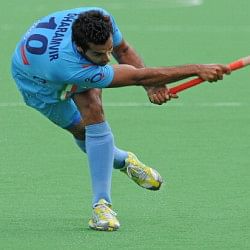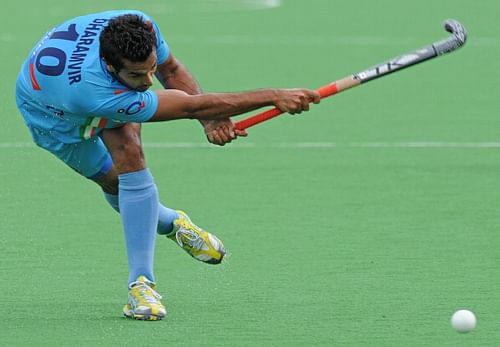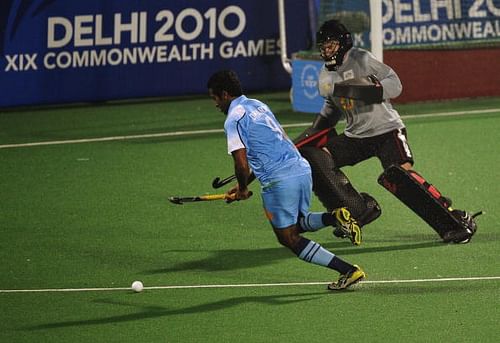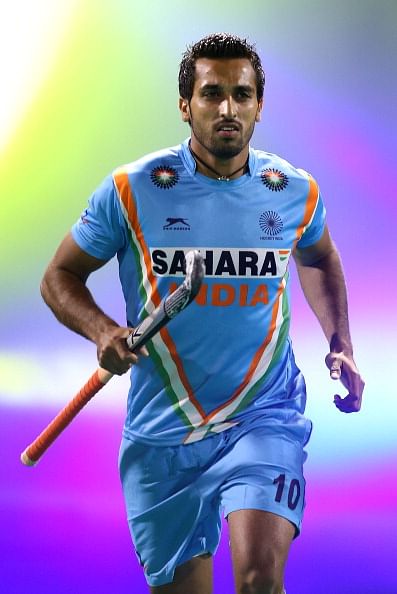
Interview: Staging comeback after injury never easy, says Indian hockey forward Dharamvir Singh

Considered one of the most talented forwards to emerge in recent times, Dharamvir Singh brings plenty of positive energy and impetus to the Indian forward line.
The 22-year-old Ropar-born youngster was in fine form in the 22nd Sultan Azlan Shah Cup in Malaysia. Although he did not make the scoresheet, his contributions didn’t go unnoticed.
At the Hero Hockey World League Round 2 tournament, ‘Dharma’, as he is known by his team-mates, was in full cry, scoring in every match of the event. He scored a crucial match-winner against Ireland, which helped India edge out their opponents 3-2.
“I was pretty chuffed with my performance. My match-winner against Ireland gave me a lot of satisfaction as they were threatening to take the match away from us,” Dharamvir says in an exclusive interview to Sportskeeda.
He attributes his recent improved performance to the productive stint he had in the Hockey India League while turning out for the Jaypee Punjab Warriors. “HIL experience was a big learning curve for me. It has allowed me to work on my finishing. Frankly speaking, I’m a much more confident player now,” he says matter-of-factly.

Dharamvir, who has played 75 internationals and scored 15 goals till date, is a product of the Chandigarh Hockey Academy. “I honed my skills in my formative years under the guidance of late Jaswinder Singh Bajwa. I enrolled myself at the Chandigarh Hockey Academy in 2002 and was there till 2008,” he reminisces.
The son of a farmer, Dharamvir got inspired to take up hockey after seeing his elder brother in action. “My elder brother Kulwinder Singh plays for Army and he was a source of inspiration for me.”
At the junior level, Dharamvir was the player of the tournament in the Four Nations tournament in Singapore in 2006. He later also emerged as the second highest goalscorer in the Six Nations tourney in Malaysia in 2007.
The well-built forward made his senior international debut during the seven-match Test series against Canada in 2009. “I played four out of the seven games. Our coach Jose Brasa tried me out in the midfield position in that series,” he recounts.
The year 2010 was a bit of a mixed bag for Dharamvir. He was not considered for the 2010 World Cup (held in New Delhi) and the Sultan Azlan Shah Cup, but was recalled for 2010 Commonwealth Games and 2010 Asian Games.
“I scored three goals in the Commonwealth Games and four in the Asian Games. I was able to prove myself in the team,” he says.
A knee injury derailed Dharamvir’s career, as he was out of competitive action for more than a year, although he stayed in touch with the national team. “I used to attend the camps and do my rehab with the boys, which included body strengthening exercises.”
The Punjab lad staged a comeback to the national side at the 2012 Sultan Azlan Shah Cup tournament. “This was my first tournament after the 2010 Asiad,” he quips.

The time spent on the sidelines made him realize how difficult it is to stage a comeback after recovering from an injury. “Staging a comeback after an injury is never easy. So many youngsters arrived in the national side during the time I was laid low by injury. Trust me, I had to work really hard to make a comeback,” he paints a realistic picture.
He, however, likes the cut-throat competition in the Indian team. “It’s good for the team. It ensures no player is complacent. It is heartening to see so many youngsters come through the ranks.”
Dharamvir is also specializing the art of ‘injecting’ penalty corners. He says, “Look, the fate of a penalty corner depends on how well a PC is injected. I have been practising my injection skills for 4-5 years and now feel more at ease executing it.”
Dharamvir, whose favourite hockey players are Jamie Dwyer and Baljit Singh Dhillon, says that the Indian team is focused about qualifying for the Hockey World League semfinals to be held later this year. “We have a good team and will qualify for round 3,” says the Indian right-in, whose favourite goal-tender is Jaap Stockmaan of Netherlands. “Stockmaan is the most difficult goalkeeper to breach. Even during practise I find it hard to break his defence.”
He does not see any difference in skills between the Indian players and the Europeans or the Aussies. “These countries have solid exposure to astroturfs and their youngsters play on such turfs from an early age. Jaap Stockmaan was telling me they are 600 astroturfs in Netherlands. We just need more astroturfs in India,” he remarks.
He also mentions that he won’t forget one pep talk from Jamie Dwyer in a hurry. “He used to tell us never to give up till the final hooter is blown even if we are on the verge of losing a match,” he signs off.